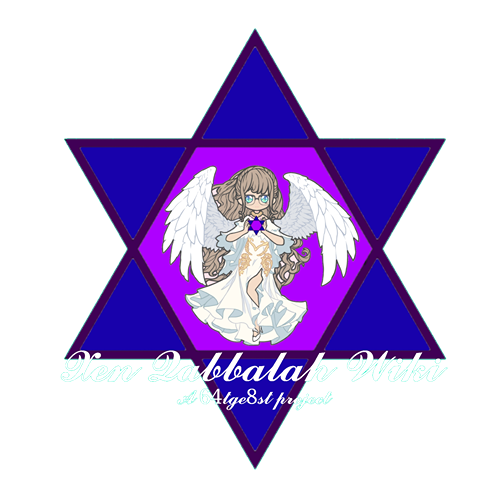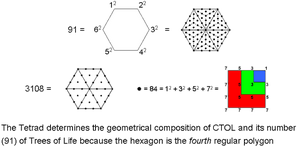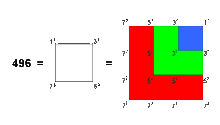The Sri Yantra is revered by Hindus as the most powerful and sacred of the yantras, or images for meditation. It represents the process of unfolding of Divine Creation from the Absolute, which is symbolized by the point, or so-called "bindu," at its centre. Five downward-pointing triangles symbolizing the feminine creative energy, or Shakti, intersect four upward-pointing triangles symbolizing the masculine creative energy, or Shiva. This generates 42 triangles arranged (in the pyramidal form called Meru in India) in layers of eight, ten, ten & 14 triangles. They surround a downward-pointing, central triangle whose corners denote the triple Godhead, or trimûrti, of Shiva, Brahma & Vishnu. Eight lotus petals are symmetrically arranged in a circumscribing circle and 16 lotus petals are likewise arranged in a larger circle. Surrounding the triangles and petals are three circles equally spaced apart. They are enclosed in a square with "doorways" in the middle of each side. There are plane (as shown on page 1), pyramidal (see here) and spherical forms (see here) of the Sri Yantra. In India there are even temples with its architecture. The Vidyashankara temple at Sringeri in India claims to possess the oldest known form of the Sri Yantra.

The Sri Yantra is generated by the overlapping of five downward-pointing triangles (shown in blue) and four upward-pointing triangles (shown in red). According to Tantra, creation on every level and scale is the product of the union of the opposite polarities of the male and female principles. In Hinduism, these archetypes are embodied in the God Shiva and the Goddess Shakti. For this reason, the downward-pointing triangles are called "Shakti triangles" and the upward-pointing triangles are called "Shiva triangles." Notice that the nine triangles consist of four pairs of Shiva & Shakti triangles, two pairs of which are mirror images of each other, and an extra Shakti triangle that is unpaired. The lowest corner of this triangle is directly below the lowest corner of the central triangle enclosing the bindu (black dot). The latter corner is the only corner of the central triangle that is not also a corner of one of the 42 triangles that surround the bindu in the 2-dimensional Sri Yantra.
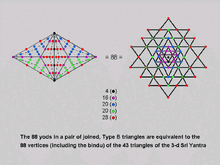
The 43 triangles of the 3-dimensional Sri Yantra have 87 corners. 87 is the number value of Levanah, the Mundane Chakra of Yesod. Four black yods consist of the bindu and the three corners of the central triangle, 16 violet yods are corners of the first layer of eight triangles, 20 blue yods are corners of the second layer of ten triangles, 20 green yods are corners of the third layer of ten triangles and 28 red yods are corners of the fourth layer of 14 triangles.
A Type B triangle has 46 yods. Two Type B triangles joined at one side have 88 yods. They comprise four black yods on the shared side, 16 violet yods on the six internal sides of Type A triangles, 20 blue yods in a pair of Type A triangles, 20 green yods in two more Type A triangles and 28 red yods inside the two remaining Typa A triangles and on external sides of the two Type B triangles.
The power of the tetractys is such that it can transform two joined triangles into an object that is equivalent to the famous Sri Yantra! Here is how the simplest triangle is revealed by its construction from tetractyses to be equivalent to half the Sri Yantra. The latter cannot, of course, be split into two halves that are exact mirror images of each other, unlike the yods in the two joined, Type B triangles in the inner Tree of Life. However, the isomorphism between the Sri Yantra and these triangles as outlined above is established through a one-to-one correspondence between yods and corners. It is unnecessary to this isomorphism that one sacred geometry should exhibit the same mirror symmetry as the other one.
The human diploid number is 46, i.e., a male or female cell contains 46 chromosomes. There are also 46 bones in the human axial skeleton that exist as pairs in the left-hand and right-hand sides of the body

A pair of joined squares is analogous to the Sri Yantra. The 21 yods outside their shared side in the four tetractyses of each square correspond to the 21 triangles in each half of the Sri Yantra. That this is not mere coincidence is indicated by the fact that four classes of yods can be identified whose numbers are the numbers of triangles in the four layers of the Sri Yantra. This identification is unique in that no other choices of yods are possible that preserve the mirror symmetry of their distribution with respect to the root edge as mirror.
The four yods on the root edge are to be associated with the pair of joined triangles rather than with the pair of squares, for both types of joined polygons are members of the two sets of seven enfolded polygons of the inner Tree of Life.

Some of the corners of triangles in the layers of the pyramidal, or 3-dimensional, Sri Yantra lie vertically above corners of triangles in adjacent layers. Such pairs of corners are denoted by pairs of differently coloured half-circles in the two diagrams above. The central triangle lies directly above the first layer of eight triangles. Above it is the bindu, representing the Absolute, the source of the Divine Creation mapped by the Sri Yantra. The numbers of corners of triangles in the various layers shown in Figure 1 are:
Central triangle: 3 white corners;
Layer 1: (8+8=16) violet corners of 8 violet triangles;
Layer 2: (10+20=20) blue corners of 10 blue triangles;
Layer 3: (10+10=20) yellow corners of 10 yellow triangles;
Layer 4: (14+14=28) red corners of 14 red triangles.
87 corners of 43 triangles surround the centre (black circle) of the central triangle, above which hovers the bindu (black dot). 87 is the number value of Levanah, the Mundane Chakra of Yesod, which is the penultimate Sephirah of Construction. The 3-dimensional Sri Yantra constitutes a system of 89 points when the centre of the central triangle is included. The number 89 is the 11th member of the well-known Fibonacci sequence:
1, 1, 2, 3, 5, 8, 13, 21, 34, 55, 89, 144, 233, ...
whose members an are defined by: an = an−1 + an−2, where a0 = 0 and a1 = 1. Given that the bindu is an independent point that — in the pyramidal Sri Yantra — lies on the vertical axis passing through the centre of the central triangle, the latter point is needed to define this axis orthogonal to the parallel layers of triangles so as to fix the position of the bindu relative to them. This means that a minimum number of (1+1+87=89) points is needed to construct the Sri Yantra in three dimensions. The bindu corresponds to the number 1, the first member of the sequence, whilst the centre of the central triangle corresponds to the second member, which is also 1. In Figure 2, the 89 points consist of the 34 green tips of the (10+10+14=34) triangles in layers 2, 3 & 4 and 55 remaining points. The latter comprise 34 brown corners at the bases of the 34 triangles in layers 2, 3 & 4 and 21 points made up of the 16 corners of the eight triangles in layer 1, namely, eight orange tips & eight violet corners at their bases, the three white corners of the central triangle, its centre (black circle) and the bindu (black dot) hovering directly above it.
All the Fibonacci numbers up to 89 measure various sets of points that shape the geometry of the 3-dimensional Sri Yantra. If these sets had been created by a highly contrived selection of points, there would, obviously, be no significance to this pattern of Fibonacci numbers in the Sri Yantra because of the lack of underpinning of these points by its geometry. But this is not the case here. The first 11 Fibonacci numbers are compounded from corners of complete sets of triangles in the layers, not from bits and pieces of them cherry-picked to generate the right numbers. The correlation between these numbers and the geometrical features of the Sri Yantra that underpin them is natural, not artificially contrived. It is implausible, therefore, to suggest that it could be just coincidence that there are 89 points, of which 21 points do not belong to the last three layers of triangles and 55 are not tips of the latter, leaving 34 points that are tips. What is the probability of four consecutive, Fibonacci numbers appearing by chance so naturally?!
The 43 triangles have 129 sides, where 129 is the number value of YAHWEH SABAOTH, the Godname of Netzach. The 42 triangles in the four separate layers have 84 corners, where
84 = 12 + 32 + 52 + 72,
and 126 sides, i.e., (84+126=210=21×10) corners & sides, showing how EHYEH, the Godname of Kether with number value 21, prescribes the 3-dimensional Sri Yantra. Therefore, 84 points and (126+42=168) lines & triangles surround the central triangle. This is one way in which the Sri Yantra embodies the superstring structural parameters 84 & 168(for other ways, see Superstrings as sacred geometry/Sri Yantra ). (87+129=216) points & lines surround the axis that passes through the bindu and the centre of the central triangle. 216 (=63) is the number of Geburah, which is the sixth Sephirah of Construction, counting from Malkuth.
When all the 43 triangles are Type A, the centres of the 42 triangles surrounding the central one become added to the 89 points, generating 131 points, where 131 is the number value of Samael, the Archangel of Geburah. Each Type A triangle has 15 hexagonal yods, so that the number of hexagonal yods in these 42 triangles = 42×15 = 630. Alternatively, Table 6 in Article 35 proves that 630 yods line the boundary of the 126 tetractyses that make up the 42 Type A triangles surrounding the central triangle. This is the number value of Seraphim, the Order of Angels assigned to Geburah. Notice also that, as the tips of six of the 14 triangles in the fourth layer touch the circle circumscribing the base of the pyramidal Sri Yantra, (42−6=36) of the 42 triangles do not touch it. The value of ELOHA, the Godname of Geburah, is 36. We find that four number values referring to the same Sephirah, namely, 216, 36, 131 & 630, emerge naturally from simple considerations of the geometrical composition and yod populations of the 3-dimensional Sri Yantra. Such an amazing conjunction cannot, plausibly, be dismissed as coincidence.

There are 504 SLs in the 91 Trees of Life in CTOL down to the top of the 7-tree that maps the physical plane (26-dimensional space-time). The 84 Trees above it comprise the 42 Trees mapping the 42 subplanes of the six cosmic superphysical planes and the 42 analogous Trees that map the 42 subplanes of the six superphysical planes. The 252 SLs down to the top of the 49-tree mapping the 49 subplanes of the cosmic physical plane consist of three sets of 84 SLs. The 84 light red SLs span the Pillar of Mercy, the 84 light blue SLs span the Pillar of Judgement and the 84 light green SLs span the central Pillar of Equilibrium. There are three more similar sets of dark red, dark blue & dark green SLs down to the top of the 7-tree. Hence, 168 light & dark green SLs line the central pillar down to this point. This is how the number value 168 of Cholem Yesodeth, the Mundane Chakra of Malkuth, specifies that section of CTOL that is its Malkuth level, namely, the 7-tree, or physical plane. Forty-six more black SLs in the 7-tree extend to the lowest point of CTOL. Each of the seven cosmic planes expresses one of the seven Sephiroth of Construction, as do the seven subplanes comprising each cosmic plane, the seven planes of the cosmic physical plane and the seven subplanes of each of these planes.
Compare these properties with the 3-dimensional Sri Yantra when the 42 triangles are turned into Type A triangles and the central one is turned into a Type B triangle. The seven planes of consciousness have a one-to-one correspondence with the seven Sephiroth of Construction (physical↔Malkuth, astral↔Yesod, mental↔Hod, etc). The six superphysical planes are associated with the six Sephiroth of Construction other than Malkuth. In the tetractys, the latter are symbolized by the six hexagonal yods that lie on its edges, the central hexagonal yod denoting Malkuth. The 504 hexagonal yods that line the sides of the 126 tetractyses in the 42 triangles of the Sri Yantra are the counterpart of the 504 SLs belonging to the 84 Trees of Life mapping all superphysical realms of consciousness. The counterpart of the 46 SLs below the top of the 7-tree are the 46 black yods in the central triangle. The presence of the 504 hexagonal yods on sides of tetractyses would, of course, continue if it were the 2-dimensional version of the Sri Yantra that was being considered. So either version can be considered as equivalent to CTOL. However, the point at the centre of the central triangle is regarded in Tantra as the source of creation and this does not fit its symbolizing the bottom of CTOL — the opposite to this, being the final emanation of God. But then the central triangle symbolizes, according to Tantra, the trimûrti of Shiva, Brahma & Vishnu, and this is inconsistent with its identification with the physical universe mapped by the 7-tree. In order to retain the traditional meaning of the bindu point as standing outside all realms of consciousness, being their source, it does make a difference which version of the Sri Yantra is the correct counterpart of CTOL. Only its 3-dimensional form, which has this point hovering above the central triangle and the four layers of 42 triangles stacked on top of one another, is the right counterpart.
This encoding of CTOL in the Sri Yantra has its counterpart in a Type C dodecagon. The section Power of the polygons/dodecagon discusses the properties of this polygon. It is the single, polygonal representation of the archetypal pattern embodied in sacred geometries of western and eastern religions. The centre of the Type C dodecagon is surrounded by 504 yods:
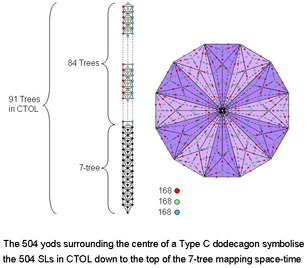
There are 168 red SLs above the 7-tree on the left-hand Pillar of Judgement of the 91 Trees of Life representing CTOL. There are 168 blue SLs above the 7-tree on the right-hand Pillar of Mercy. 168 green SLs span the central Pillar of Equilibrium down to the top of the 7-tree. There are 14 green yods per sector of the Type C dodecagon that are either corners of tetractyses or hexagonal yods at their centres. The 9 tetractyses per sector have 14 sides, a red and a blue hexagonal yod lying on each one. Hence, the 504 yods surrounding the centre of the dodecagon comprise (12×14=168) yods that are either red, green or blue. They symbolise the three sets of 168 SLs lining the three pillars of CTOL down to the top of the 7-tree.
They form three sets of 168 yods (coloured red, green & blue) because each sector of the Type C dodecagon has nine tetractyses with 14 sides, each having a pair of red & blue hexagonal yods, and 14 green yods that are either corners of tetractyses or their centres, so that the (12×9=108) tetractyses contain (12×14=168) red hexagonal yods, 168 blue hexagonal yods and 168 green yods. These sets correspond to the 168 SLs on the three pillars of CTOL down to the top of the 7-tree mapping the physical plane (space-time). Hence, the Type C dodecagon is equivalent to the 3-dimensional Sri Yantra. Its centre corresponds to the central Type B triangle, whose 46 yods denote the 46 SLs below the top of the 7-tree. Its 504 yods correspond to the 504 hexagonal yods on the 252 sides of the 126 tetractyses making up the 42 Type A triangles of the Sri Yantra; they symbolise the 504 SLs in CTOL down to the top of the 7-tree.
The 91 overlapping Trees of Life in CTOL are composed of 3108* corners, sides & triangles, where
3108 = 14 + 34 + 54 + 74,
i.e., this number is the sum of the fourth powers of the first four odd integers. The geometrical composition of CTOL is determined by the Tetrad:
Notice that 3108 = 444×7, where 7 is the fourth odd integer. As 3108 = 37×84, where 37 is the number of yods in the Type A hexagon, the fourth type of regular polygon, and 84 = 12 + 32 + 52 + 72, we see that the Tetrad determines the number quantifying the geometrical composition of CTOL, as well as its number (91) of Trees of Life, because the Type B hexagon has 91 yods:
The Tetrad also expresses the geometrical composition of the 2-dimensional Sri Yantra because 240 corners, sides & triangles surround its centre, where 240 = 10×24 = 1×2×3×4×(1+2+3+4). The physical plane (the space-time continuum) is mapped in CTOL by its lowest seven Trees of Life and in the Sri Yantra by its central triangle. As space-time, it is the Malkuth level of the 49-tree mapping the cosmic physical plane, the gematria number value of this Sephirah being 496, where
It is no coincidence that this number is that found in 1984 by physicists Michael Green and Gary Schwarz to be the crucial dimension of a Yang-Mills gauge symmetry group governing the interactions of 10-dimensional superstrings that are free of quantum anomalies. It was then that research in theoretical physics encountered for the first time a mathematical aspect of the universe that is revealed by Kabbalah. This superstring parameter is embodied in the cosmic physical plane as the 496 yods either lying on or aligned with the Pillar of Equilibrium of 49 overlapping Trees of Life when their triangles are tetractyses.** Making use of the formula proved in the first footnote, these 49 Trees are composed of (34×49 + 14 = 1680) points, lines & triangles. Here is a spectacular conjunction of the two most fundamental parameters of E8×E8 heterotic superstrings — one (496) referring to their forces described by the symmetries of E8×E8 and one (1680), yet to be discovered by physicists, that refers to their 4-dimensional space-time structure, namely, the 1680 circular turns of each helical whorl of the UPA counted by C.W. Leadbeater when he observed it with micro-psi over a century ago. Here in the conjunction between two numbers referring to the same context is an undeniable meeting point of the mystical, the scientific and the paranormal. Provided he is honest, even the most die-hard sceptic towards the paranormal would admit that it is too unlikely that the simultaneous appearance of these two numbers (one scientifically based, one of paranormal origin) in the Tree of Life representation of the cosmic physical plane might be due to chance. Yet the sceptic is forced to embrace the miraculously improbable in order to avoid believing what is anathema to him, namely, that remote viewing of the subatomic world is possible and was successfully achieved by Besant & Leadbeater. No one should be fooled by the sceptic's disbelief in the paranormal forcing him to reject all common sense concerning what can be reasonably regarded as coincidence.
Sri Yantra and energy
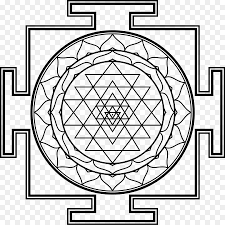
The Sri Yantra graphs the harmonizing of all energy that eventually occurs throughout creation. A “yantra” graphs energy as it moves through its own field, or merkaba(star tetrahedron).
Yantras are often incorporated into mandalas. “Mandala” means circle, in Sanskrit. So when a yantra is created into a schematic of the universe, it is also a mandala.
The Sri Yantra is so highly revered because it accurately depicts the process by which, when spirit emerges from source (the central point) and descends into matter (three downward facing triangles – symbolic of matter or the feminine creation), eventually it self-corrects and sends up an ascending triangle (a symbol for spirit, or the masculine aspect of the universe). While initially these triangles are not equilateral, and hence move back and forth between the two energies, they finally each become equilateral and order is restored in the universe.
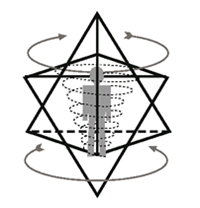
This final equilateral triangle overlap is also known in the Far East as the Creation Yantra and, in the west, as the Star of David or star tetrahedron. Our human energy field is a star tetrahedron in action, and when we are in balance, the two sides are both spinning well, as shown here, and we are content.
Sri Yantra represents the microcosmic level of the Universe and the body
Each circuit in Sri Yantra corresponds to one of the chakras in the human body. An ever rotating and expanding Sri Yantra represents the Universe. All 9 interlocking triangles lead to a creation of 43 smaller triangles; each one of these represents a deity associated with a certain aspect of the existence.
Structure of the universe
The symbol known as the Sri Yantra is an ancient Hindu symbol comprised of 9 triangles that are interlaced in such a way as to form 43(7) smaller triangles in a web said to be symbolic of the entire cosmos(infinite multyvers). The 64 tetrahedron grid is also the foundational seed geometry of the fabric of the vacuum(black hole(mirror infinite multyvers)/kugleblits(infinite multyvers)) according to Nassim Haramein's Unified Field Theory. Everything is connected by the structure of spacetime(infinite multyvers).
the geometric form of the Goddess Herself
Sri Chakra is said to represent the infinite power of the Goddess; it is the geometric form of the Goddess Herself.
The bindu
The bindu(keter) represents the location of the highest manifestation of the deity as well as the focal point through which the deity transcends the relative plane, with its form and structure to merge into the formless consciousness. To help visually understand, the bindu is the center of the Sri Yantra and the dot is the symbol of AUM – it represents the piercing, breaking or bursting through (bindu vedhana) and it is the final stage. This is the very same formless consciousness in which the devotee merges with the highest truth.
Om and the sri yantra
Om sounded in tonoscope creates a geometric pattern like the Sri Yantra. 108 is believed to be the numeric representation of Aum and Sri Yantra, the visual representation.
